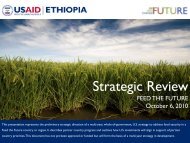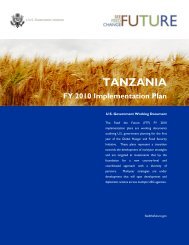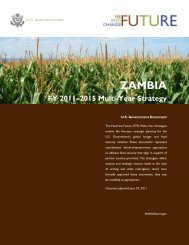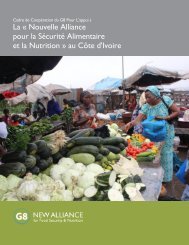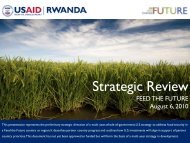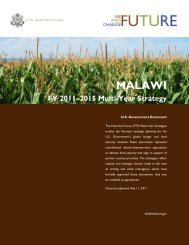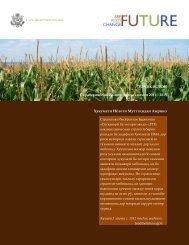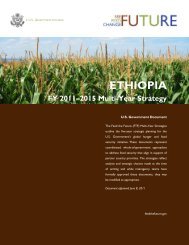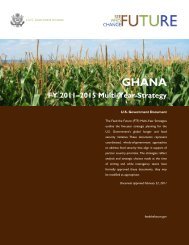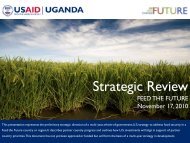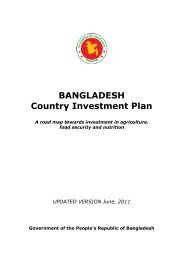Feed the Future Multi-Year Strategy, Uganda, Public
Feed the Future Multi-Year Strategy, Uganda, Public
Feed the Future Multi-Year Strategy, Uganda, Public
Create successful ePaper yourself
Turn your PDF publications into a flip-book with our unique Google optimized e-Paper software.
1. INTRODUCTION<br />
<strong>Uganda</strong>’s <strong>Feed</strong> <strong>the</strong> <strong>Future</strong> (FTF) strategy rests upon our analysis of <strong>the</strong> way poverty and nutritional<br />
status interact in <strong>Uganda</strong>. While a logical assumption might be that as families’ incomes increase, <strong>the</strong>y<br />
have more money to spend on nutritious food and <strong>the</strong>refore nutritional status also increases, in fact<br />
<strong>the</strong>re is only a loose correlation between higher income and improved nutrition. While <strong>the</strong>re is<br />
43.4percent stunting in <strong>the</strong> lowest wealth quintile, stunting rises to 44 percent in <strong>the</strong> middle wealth<br />
quintile and only drops to 25 percent in <strong>the</strong> highest wealth quintile 1 This insight is illustrated by <strong>the</strong><br />
fact that one of <strong>the</strong> regions with <strong>the</strong> highest rates of stunting (49.6 percent) is in <strong>the</strong> Southwest, known<br />
as <strong>the</strong> country’s bread basket. This unexpected insight is <strong>the</strong> basis for our strategy.<br />
<strong>Uganda</strong>’s FTF strategy is <strong>the</strong>refore built on three components. The components include: 1) Agriculture<br />
and 2) Nutrition, which address head-on <strong>the</strong> twin objectives of <strong>the</strong> global FTF initiative. The third<br />
component:3) Connecting Nutrition to Agriculture, seeks to eliminate <strong>the</strong> disconnect between<br />
improved agriculture and improved nutrition. It will take an evidence based approach to understand<br />
and scale up what is necessary to make nutrition improve alongside agriculture, focusing on household,<br />
gender, and nutrition practices. The integration of two separate technical disciplines, agriculture and<br />
health/nutrition, is at <strong>the</strong> core of our strategy. The strategy leverages what we have learned over <strong>the</strong><br />
past 15 years working in agriculture in <strong>Uganda</strong>—<strong>the</strong> text references earlier projects successes and<br />
failures as we made program decisions for this strategy.<br />
Figure 1.Activity-Component Relationships<br />
Summary of Objectives, Beneficiaries, Geographic Targets<br />
Nutrition<br />
Who/Where/Why: This component will reach children in 47 districts in <strong>the</strong> Southwest and North of<br />
<strong>Uganda</strong>. These regions were chosen because <strong>the</strong>y represent <strong>the</strong> worst stunting and wasting in <strong>the</strong><br />
country; specific districts were chosen to complement <strong>the</strong> locations of similar programs that are not<br />
funded directly with FTF funding (see Table 2 for details).<br />
What: Some key outputs of nutrition activities are: nutrition officers placed in a majority of districts;<br />
active Food and Nutrition Councils organized in districts; mandatory fortification of major<br />
1 <strong>Uganda</strong> Demographic and Health Survey - 2006<br />
5



